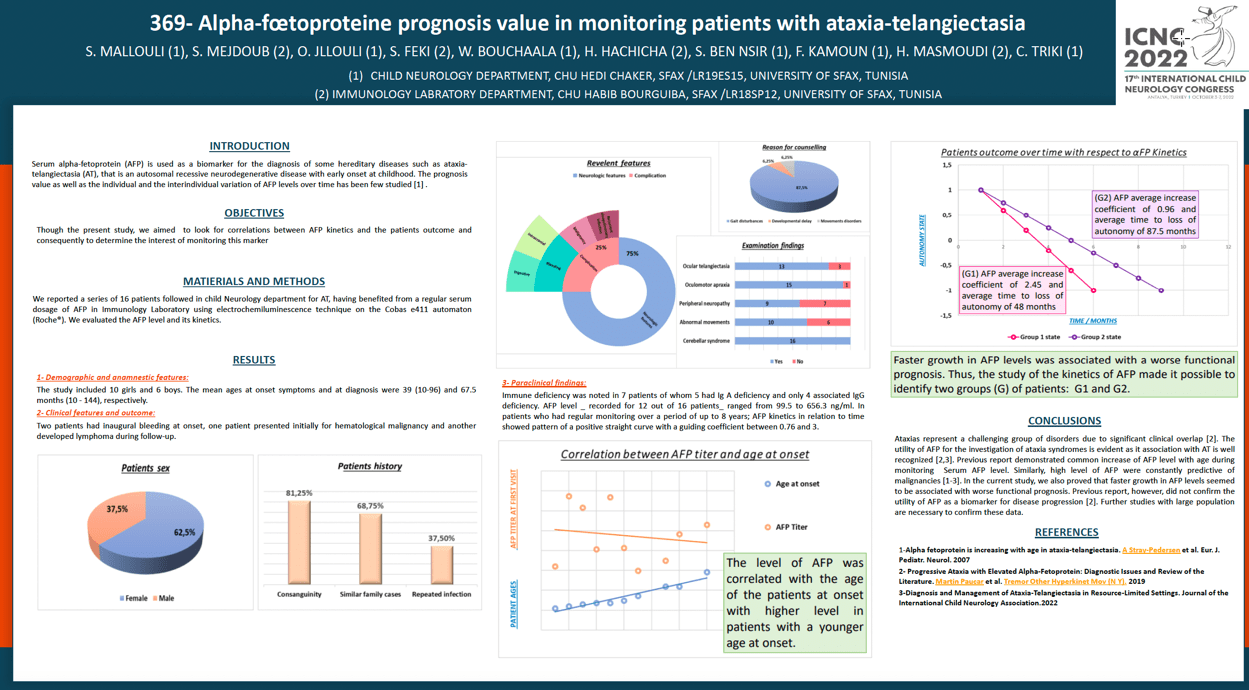ALPHA-FŒTOPROTEINE PROGNOSIS VALUE IN PATIENTS MONITORING WITH ATAXIA-TELANGIECTASIA
Salma Zouari Mallouli, Sabrina Mejdoub, Olfa Jallouli , Sawssan Feki, Wafa Bouchaala, Hend Hachicha, Sihem Ben Nsir, Fatma Kamoun Feki, Hatem Masmoudi, Chahnez Charfi Triki
Introduction: Serum alpha-fetoprotein (AFP) is used as a biomarker for the diagnosis of some hereditary diseases such as ataxia-telangiectasia (AT), that is an autosomal recessive neurodegenerative disease with early onset at childhood. Materials and methods: We reported a series of 16 patients followed in child Neurology department for AT, having benefited from a serum dosage of AFP in Immunology Laboratory using electrochemiluminescence technique on the Cobas e411 automaton (Roche®). Results : The study included 10 girls and 6 boys. The mean ages at onset symptoms and at diagnosis were 39 (10-96) and 67.5 months (10-144), respectively. Consanguinity and similar family cases were found in 81.25% and 68.75%. A history of repeated infections was noted in 6 patients (37.5%). Considering the whole population study, AFP level ranged from 99.5 to 656.3 ng/ml. In patients who had regular monitoring, AFP kinetics in relation to time showed pattern of a straight curve with a guiding coefficient between 0.76 and 3. The level of AFP was correlated with the age of the patients at onset with higher level in patients with a younger age at onset. Faster growth in AFP levels was associated with a worse functional prognosis and earlier loss of autonomy. Discussion and conclusion: Serum AFP level is of diagnostic interest in ataxia-telangiectasia. A frank elevation of this marker, in front of an evocative clinical picture, confirms the diagnosis. Faster growth in AFP levels was associated with worse functional prognosis. Further study with large population is necessary to confirm these data.
Keywords: Alpha Foeto protein kinetics, ataxia-Telangiectasia, prognosis value
Salma Zouari Mallouli
Hedi Chaker Sfax University Hospital And Research Laboratory LR19ES15, Sfax University, Tunisia
Tunisia
Sabrina Mejdoub
Habib Bourguiba Sfax University Hospital And Research Laboratory LR18SP12, Sfax University, Tunisia
Tunisia
Olfa Jallouli
Hedi Chaker Sfax University Hospital And Research Laboratory LR19ES15, Sfax University, Tunisia
Tunisia
Sawssan Feki
Habib Bourguiba Sfax University Hospital And Research Laboratory LR18SP12, Sfax University, Tunisia
Tunisia
Wafa Bouchaala
Hedi Chaker Sfax University Hospital And Research Laboratory LR19ES15, Sfax University, Tunisia
Tunisia
Hend Hachicha
Habib Bourguiba Sfax University Hospital And Research Laboratory LR18SP12, Sfax University, Tunisia
Tunisia
Sihem Ben Nsir
Hedi Chaker Sfax University Hospital And Research Laboratory LR19ES15, Sfax University, Tunisia
Tunisia
Fatma Kamoun Feki
Hedi Chaker Sfax University Hospital And Research Laboratory LR19ES15, Sfax University, Tunisia
Tunisia
Hatem Masmoudi
Habib Bourguiba Sfax University Hospital And Research Laboratory LR18SP12, Sfax University, Tunisia
Tunisia
Chahnez Charfi Triki
Hedi Chaker Sfax University Hospital And Research Laboratory LR19ES15, Sfax University, Tunisia
Tunisia
Introduction: Serum alpha-fetoprotein (AFP) is used as a biomarker for the diagnosis of some hereditary diseases such as ataxia-telangiectasia (AT), that is an autosomal recessive neurodegenerative disease with early onset at childhood. Materials and methods: We reported a series of 16 patients followed in child Neurology department for AT, having benefited from a serum dosage of AFP in Immunology Laboratory using electrochemiluminescence technique on the Cobas e411 automaton (Roche®). Results : The study included 10 girls and 6 boys. The mean ages at onset symptoms and at diagnosis were 39 (10-96) and 67.5 months (10-144), respectively. Consanguinity and similar family cases were found in 81.25% and 68.75%. A history of repeated infections was noted in 6 patients (37.5%). Considering the whole population study, AFP level ranged from 99.5 to 656.3 ng/ml. In patients who had regular monitoring, AFP kinetics in relation to time showed pattern of a straight curve with a guiding coefficient between 0.76 and 3. The level of AFP was correlated with the age of the patients at onset with higher level in patients with a younger age at onset. Faster growth in AFP levels was associated with a worse functional prognosis and earlier loss of autonomy. Discussion and conclusion: Serum AFP level is of diagnostic interest in ataxia-telangiectasia. A frank elevation of this marker, in front of an evocative clinical picture, confirms the diagnosis. Faster growth in AFP levels was associated with worse functional prognosis. Further study with large population is necessary to confirm these data.
Keywords: Alpha Foeto protein kinetics, ataxia-Telangiectasia, prognosis value
Salma Zouari Mallouli
Hedi Chaker Sfax University Hospital And Research Laboratory LR19ES15, Sfax University, Tunisia
Tunisia
Sabrina Mejdoub
Habib Bourguiba Sfax University Hospital And Research Laboratory LR18SP12, Sfax University, Tunisia
Tunisia
Olfa Jallouli
Hedi Chaker Sfax University Hospital And Research Laboratory LR19ES15, Sfax University, Tunisia
Tunisia
Sawssan Feki
Habib Bourguiba Sfax University Hospital And Research Laboratory LR18SP12, Sfax University, Tunisia
Tunisia
Wafa Bouchaala
Hedi Chaker Sfax University Hospital And Research Laboratory LR19ES15, Sfax University, Tunisia
Tunisia
Hend Hachicha
Habib Bourguiba Sfax University Hospital And Research Laboratory LR18SP12, Sfax University, Tunisia
Tunisia
Sihem Ben Nsir
Hedi Chaker Sfax University Hospital And Research Laboratory LR19ES15, Sfax University, Tunisia
Tunisia
Fatma Kamoun Feki
Hedi Chaker Sfax University Hospital And Research Laboratory LR19ES15, Sfax University, Tunisia
Tunisia
Hatem Masmoudi
Habib Bourguiba Sfax University Hospital And Research Laboratory LR18SP12, Sfax University, Tunisia
Tunisia
Chahnez Charfi Triki
Hedi Chaker Sfax University Hospital And Research Laboratory LR19ES15, Sfax University, Tunisia
Tunisia

Chahnez Charfi Triki
Hedi Chaker Sfax University Hospital And Research Laboratory LR19ES15, Sfax University, Tunisia
Tunisia